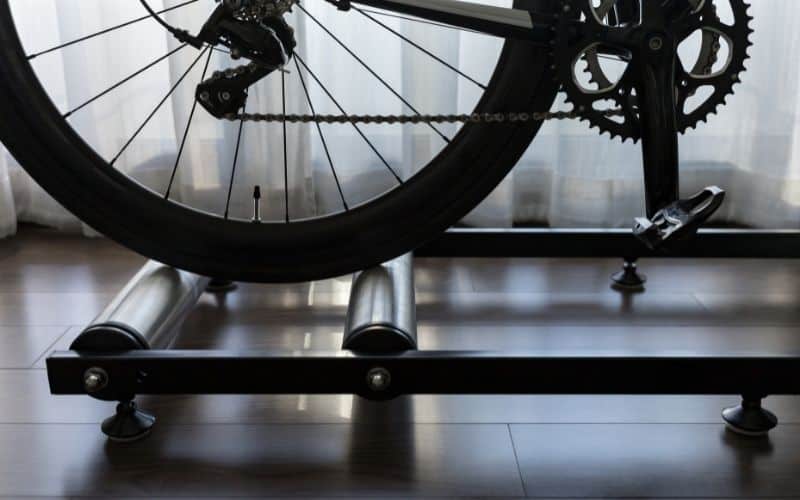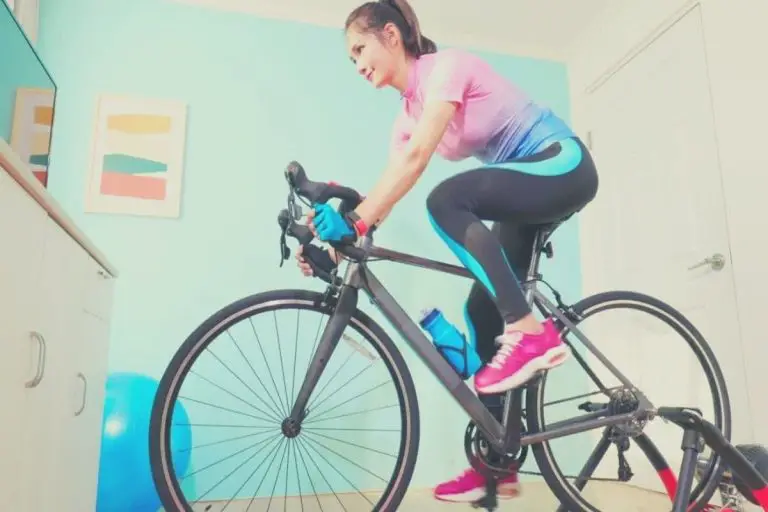If you’re like me, your indoor trainer is still getting a lot of use. I must admit, I started to worry about what damage I was doing to my indoor bike.
The good news is, there are a few things you can do to minimize the damage!
Let’s look at how to prevent your indoor trainer from damaging your bike?
A specific trainer tire will save you from replacing your tires so frequently. Use the skewers included with the trainer and try to minimize corrosion by keeping your sweat off the bike as much as you can.
How To Set Up Your Bike For Indoor Training
Getting your setup correct is essential. Failing to do so is likely to damage your bike and your trainer – not to mention you might hurt yourself too!
Here are a few pointers to help you get set up correctly with your bike and trainer.
- Use the tire pressure recommended on your bike. I tend to find this is usually 100 psi but I’d advocate checking the manufacturer’s website to be certain. Just like with an outdoor bike, you’re likely to need to keep checking the pressure and adjusting it. It’s important to do this, not only for safety reasons but also helps you to get consistent and accurate data so you can monitor your progress – now there’s an incentive, right?
- Ensure the clamps that go around the skewers are in place properly and are tight enough. Failing to do this will cause your bike to move. It’s dangerous for you and your bike.
- For those who keep their rear tire on the bike when connected to the trainer, adjust the roller tension knob to ensure that the tension is spot on between the roller and your tire. One way to be sure is to try and move the rear wheel. If you find that it slips, you need to tighten the knob some more. On the flip side, you don’t want to overtighten it as you could end up with too much pressure on the tire.

Protect Your Bike From Your Sweat!
Sweat can corrode your bike, surprisingly quickly. I have seen it happen to fellow cyclists when they haven’t taken the appropriate steps to protect their bikes.
I will say, it’s easy to forget about this when you’re training indoors but it’s best to get into the habit of doing a few things to help prevent corrosion.
Sweating is inevitable when you’re cycling, especially indoors. You can reduce the amount of sweat that ends up on your bike by doing the following:
- Get yourself a fan (maybe two!), this will help cool you down and it can reduce your sweating. A fan also works well to dry you so there is less chance of sweat getting onto your bike.
- A towel over your handlebars goes a long way to catch sweat dripping from your body. I usually have one that covers the top tube too.
- Wear the correct clothing! Lycra traps sweat so it’s less likely to end up on your bike. Got to be honest, if I know I’m going to be on my indoor bike for a while, I’ll even wear a cycling cap.
- Wear a pair of gloves. I admit, I struggled with this one but it does work really well at protecting the handlebars from sweat.
- Purchase a sweat guard. These are designed to catch your sweat before it ends up on the headset, downtube, or top tube.
- Wipe your bike down after every session.
- Use anti-corrosion products. Personally, I use Muc Off and find it to be easy to apply and effective!
Related article – 5 Of The Best Floor Mats For Indoor Cycling
More tips on how to keep cool when you’re cycling indoors?
Skewer Your Bike
When you’re unpacking your trainer, you will most likely come across a steel skewer. Use it!
I had this conversation with a friend just the other week, he didn’t know why he needed to use the skewer the trainer came with when his bike had a perfectly good one.
The reason is that the trainer skewer is designed to be able to handle the stress of an indoor trainer, which is different from what you find on a bike you use outdoors. Failing to use the right skewer, can cause it to become bent under the pressure. That can lead to your bike slipping from the trainer and that would cause a lot of damage to you and your bike.
Use A Trainer-Specific Tire
This one is only really relevant if you have a turbo trainer where you still keep your bike’s tire on.
So if it applies to you, I’ve got news!
Constant pressure is being applied to your bike’s tire from the trainer, what this means is that the tire wears more quickly. The best way to fix this is to use a tire specifically designed for indoor training, known as a training tire.
These tires are smoother in texture and the tread count is lower. All of this works to reduce the amount of friction between the trainer and the bike so it lasts longer.
Still not sold on the trainer tire idea?
There are other benefits!
- Reduces the noise output when you’re training so your sessions will be quieter, which can be especially helpful in apartment situations.
- It’s going to save you money! Your road tire will wear out, this way, you should find yourself replacing tires less frequently.
- One thing to mention is don’t use your trainer tire out on the road. You won’t have the grip and speaking from experience, it’s no fun and rather dicey!
If you aren’t wanting to buy a specific training tire, you can use an old tire and consider this to be your training tire. One thing to be sure of with this is that the tire is clean and there aren’t any stones in it as this can damage the trainer.
Related article – Do Rollers Damage Your Bike Tires?

Spin The Front Wheel Occasionally
It’s quite easy to forget about the front wheel. It doesn’t come into contact with the trainer, it’s just there. However, it is worth paying it a bit of attention every now and then.
Namely, rotate it.
Why?
If the wheel isn’t moving for a long time, the spokes are experiencing an uneven amount of stress, which will lead to damage or excess wear.
Before starting your workout, I’d recommend rotating your wheel a ¼ turn.
This doesn’t apply if you use the same bike for your outdoor rides and you get outside often as your wheel will obviously be rotating!
Related article – 4 Of The Best Budget Bike Trainers
Frequently Asked Questions
Are Trainers Bad For Carbon Bikes?
Riding outdoors is very different from riding on a trainer.
When you’re outdoors, you usually sway your bike and that expels some energy. Indoors, that isn’t possible but the energy still has to go somewhere. This is where it can be bad news for a carbon road bike.
However, you shouldn’t experience any damage when using a carbon bike on a trainer unless your bike is made from very cheap carbon or you are putting far too much pressure on it.
The rise of indoor riding has meant that bike manufacturers are ensuring the bikes can withstand the different forces used indoors.
As someone who has a carbon bike on their indoor trainer, I have no worries about it being damaged. Sure, I don’t go crazy at sprints, but I’m no Mark Cavendish anyway!
Here are some other thoughts:
How Do I Maintain My Trainer?
Your trainer is no different from your bike in that it does need to be maintained.
I always give mine a clean on a regular basis to remove any sweat or dust. On a less frequent basis, I ensure that the bolts are all tight and lubricate anywhere that needs doing, such as the threads on the roller tension rods.
As an extra step, I unplug my trainer when it’s not in use. I initially started this as a way to save a bit of power. However, if you leave your trainer on, it spends a long time looking for connections and well, just using power so for many reasons, switch it off!
Can You Change Gears On A Bike Trainer?
You can change gears on a bike trainer, just like you would when you’re outside.
A smart trainer is all about trying to deliver the most realistic outdoor riding experience, whilst being indoors, and with that, shifting gears works in exactly the same way and the resistance you feel is the same as if you were outdoors too.
Related article – Can You Use Zwift Without A Smart Trainer?
Final Thoughts
There we have it, the things you need to know to look after your bike, your trainer, and yourself during your indoor training. The great thing is that none of the above tips take much time or investment, it all comes down to habit. Once you’re into the habit, it’s very easy to keep up and you will likely do it without thinking.
Do you train indoors all year round?

